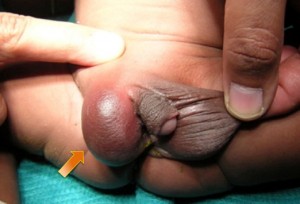Testicular torsion literally means “twisted testicle.” Inside the scrotum, each testicle is wrapped in a sack called the tunica vaginalis and hangs from a stringlike structure called the spermatic cord. The spermatic cord is a conduit that contains the nerves and blood vessels supplying the testicles. Each testicle is affixed to its tunica vaginalis, anchoring it within the scrotal sac. If the point of attachment is in the wrong place, the testicle can rotate, twisting the spermatic cord and its contents. When this happens, blood can no longer move easily up and down the spermatic cord. Poor blood flow leads to redness, swelling, and loss of oxygen at the testicle, all of which can be extremely painful. With enough loss of blood flow, the starved testicle can become permanently nonfunctional.
Testicular torsion is very rare. Most cases are seen in adolescents and adults. However, it can occur in young boys. Symptoms of torsion include pain, swelling or redness of the scrotum, and vomiting. Regardless of age, it causes excruciating pain.
What can I do?
Anytime testicular torsion is suspected, you should call or visit your doctor immediately. There is nothing for you to try at home.
 When does my doctor need to be involved?
When does my doctor need to be involved?
Testicular torsion is a surgical emergency. If it isn’t fixed right away, the consequences can be permanent. The maximum time from onset of torsion to surgery is four to six hours; beyond that, the testicle is not salvageable. Testicular torsion is one of those better-safe-than-sorry situations: don’t hesitate to call the doctor even if you are not sure your son’s condition warrants it.
What tests need to be done, and what do the results mean?
When the child’s inner thigh is stroked, the testicle on that side leaves the scrotum and rises into the pelvis. This is known as the cremasteric reflex. This reflex goes away when the testicle is twisted. Therefore, one of the easiest tests to determine whether there is testicular torsion is to try to elicit the cremasteric reflex.
A complete blood count is often checked to make sure an infection is not the cause of the symptoms. The blood count is often normal with torsion. Although an infection in the testicle can cause pain, the pain of torsion is usually more severe.
An ultrasound can be performed to look at the testicular structure. If the ultrasound has Doppler—a mode that detects blood flow — it can help determine whether the testicle has actually twisted and cut off its own blood supply.
If the diagnosis is still uncertain, a radionuclide scan of the testicle can be helpful. This test looks at the testicle and its blood flow. It is helpful in differentiating torsion from other conditions because it can demonstrate blood flow — or lack thereof — to the testicle. Radionuclide scanning has an accuracy rate of 90 to 100 percent. However, this test can take time to schedule and administer, and if torsion is suspected, sufficient time may not be available.
What are the possible complications?
The most severe complication of testicular torsion is permanent testicular non-function, or “testicular death.” This can happen when the blood supply to the testicle is cut off for more than six hours. When the testicle dies, it must be surgically removed, because it becomes a source of potential infection. This increases the chances of infertility, since the body’s sperm production is reduced by half.
